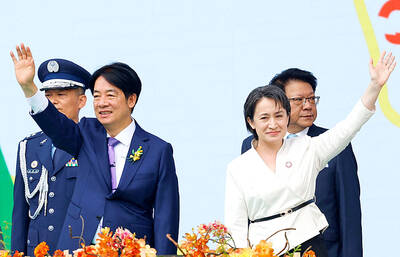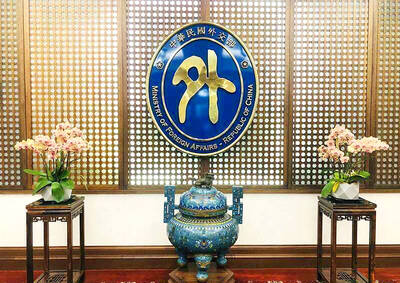The American Institute in Taiwan (AIT) yesterday announced that the installation of equipment to detect radiation at Kaohsiung Harbor had been completed, bringing Taiwan online as part of global efforts to combat the proliferation of weapons of mass destruction.
Under the auspices of the US Department of Energy’s National Nuclear Safety Administration (NNSA), the Second Line of Defense Megaports Initiative provides radiation detection equipment and training at major ports worldwide to strengthen the capability of the international community to detect and interdict trafficking in nuclear material through maritime shipping.
Better known by its shorter name, the Megaports Initiative equips ports with radiation portal monitors for the detection of radiation, handheld devices to identify radioactive isotope, optical character recognition technology to identify containers, communications equipment to send data to a central alarm station, as well as training and technical support.
The Megaports Initiative, which brings in customs, law enforcement, port authorities, terminal operators and other government agencies, is now operational in 34 ports worldwide, with work under way at 18 other ports in Asia, Latin America and the Caribbean, Europe, the Middle East and Africa. The Megaports Initiative seeks to equip 100 seaports with radiation detection systems by 2016, scanning about 50 percent of global maritime containerized cargo and more than 80 percent of US-bound container traffic.
KEY LINK
The AIT and the Taipei Economic and Cultural Representative Office signed a memorandum of understanding to implement the Megaports Initiative in Taiwan in 2006. Because of its strategic location, high volume and role as a key transshipment port in the Asian region, the inclusion of Kaohsiung Harbor in the initiative was seen as key to strengthening interdiction in the region.
Work to equip Kaohsiung Harbor began in 2007, with the installation of radiation detection equipment and training of Taiwanese officials. Because of the size of Kaohsiung Harbor, work was divided into two phases, with phase 1 involving the installation of detection equipment at terminals 2, 3 and 5, and phase 2 the completion of terminals 1 and 4, AIT said.
Kaohsiung Customs launched Megaports Initiative operations in November 2009 at all phase 1 sites, with all phase 2 sites coming online in October last year.
According to the NNSA, more than 90 percent of global commerce is transported through the maritime shipping network via cargo containers, with about 500 million twenty-foot-equivalent units — a measure of volume in the transport of containers — transiting the globe annually.
ROGUE STATES
Because of its technological base and strategic location for direct shipment or transshipment, Taiwan has become the focus of rogue states such as Iran and North Korea and non-state organizations seeking to acquire material that could be used in the production of nuclear weapons.
In August 2003, the North Korean cargo vessel Be Gaehung was detained at Kaohsiung Harbor after US intelligence notified Taiwanese authorities that the vessel was suspected of carrying chemicals associated with rocket fuel.
Reports in December 2009 showed that Iran sought to obtain hundreds of pressure transducers, which can be used to enrich uranium to weapons grade, from Heli-Ocean Technology Co, a Taiwanese agent, via a company based in Shanghai.
AIT, the US Department of Energy, the Ministry of Finance and the Directorate General of Customs will celebrate the completion of the project at a ceremony on Friday at the US Commerce and Culture Activity Center in Greater Kaohsiung, AIT said.

The German city of Hamburg on Oct. 14 named a bridge “Kaohsiung-Brucke” after the Taiwanese city of Kaohsiung. The footbridge, formerly known as F566, is to the east of the Speicherstadt, the world’s largest warehouse district, and connects the Dar-es-Salaam-Platz to the Brooktorpromenade near the Port of Hamburg on the Elbe River. Timo Fischer, a Free Democratic Party member of the Hamburg-Mitte District Assembly, in May last year proposed the name change with support from members of the Social Democratic Party and the Christian Democratic Union. Kaohsiung and Hamburg in 1999 inked a sister city agreement, but despite more than a quarter-century of

Taiwanese officials are courting podcasters and influencers aligned with US President Donald Trump as they grow more worried the US leader could undermine Taiwanese interests in talks with China, people familiar with the matter said. Trump has said Taiwan would likely be on the agenda when he is expected to meet Chinese President Xi Jinping (習近平) next week in a bid to resolve persistent trade tensions. China has asked the White House to officially declare it “opposes” Taiwanese independence, Bloomberg reported last month, a concession that would mark a major diplomatic win for Beijing. President William Lai (賴清德) and his top officials

The Ministry of Foreign Affairs (MOFA) yesterday expressed “grave concerns” after Singaporean Prime Minister Lawrence Wong (黃循財) reiterated the city-state’s opposition to “Taiwanese independence” during a meeting with Chinese Premier Li Qiang (李強). In Singapore on Saturday, Wong and Li discussed cross-strait developments, the Singaporean Ministry of Foreign Affairs said in a statement. “Prime Minister Wong reiterated that Singapore has a clear and consistent ‘one China’ policy and is opposed to Taiwan independence,” it said. MOFA responded that it is an objective fact and a common understanding shared by many that the Republic of China (ROC) is an independent, sovereign nation, with world-leading

‘ONE CHINA’: A statement that Berlin decides its own China policy did not seem to sit well with Beijing, which offered only one meeting with the German official German Minister for Foreign Affairs Johann Wadephul’s trip to China has been canceled, a spokesperson for his ministry said yesterday, amid rising tensions between the two nations, including over Taiwan. Wadephul had planned to address Chinese curbs on rare earths during his visit, but his comments about Berlin deciding on the “design” of its “one China” policy ahead of the trip appear to have rankled China. Asked about Wadephul’s comments, Chinese Ministry of Foreign Affairs spokesman Guo Jiakun (郭嘉昆) said the “one China principle” has “no room for any self-definition.” In the interview published on Thursday, Wadephul said he would urge China to